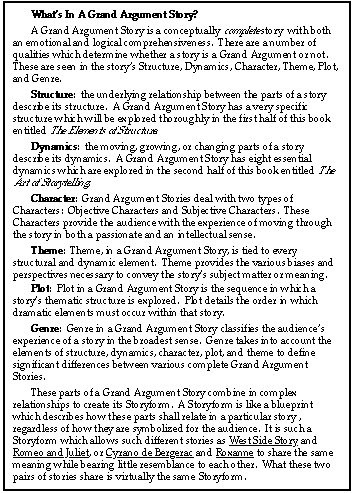A tale is a simple linear path that the author promotes as
being either a good or bad one to take, depending on the outcome.
There’s a certain amount of power in that. It wouldn’t take our early
storyteller long to realize that he didn’t have to limit himself to
relating events that actually happened. Rather, he might carry things a
step farther and create a fictional tale to illustrate the benefits or
dangers of following a particular course.
That is the concept behind Fairy Tales and Cautionary Tales – to
encourage certain behaviors and inhibit other behaviors based on the
author’s belief as to the most efficacious courses of action in life.
But what kind of power could you get as an author if you were able to
not merely say, “This conclusion is true for this particular case,” but
rather “This conclusion is true for all such similar cases”?
In other words, if you begin “here,” then no matter what path you
might take from that given starting point, it wouldn’t be as good (or as
bad) as the one I’m promoting. Now, rather than saying that the
approach you have described is simply good or bad in and of itself, you are suggesting that of all the approaches that might have been taken, yours is the best (or worst) way to go.
Now that has a lot more power to it because you are telling everyone, “If you find yourself in this situation, exclude any other paths; take only this one,” or, “If you find yourself in this situation, no matter what you do, don’t do this!”
That kind of statement has a lot more power to manipulate an
audience. But, because you’ve only shown the one path (even though you
are saying it is better than any others) you are making a blanket statement.
An audience simply won’t sit still for a blanket statement. They’ll
cry, “Foul!” They will at least question you. So, if our caveman sitting
around the fire say, “Hey, this is the best of all possible paths,” the
audience is going to say , “What about this other case? What if we tried this, this or this?”
If the author was able to successfully argue his case he would
compare all the solutions the audience might suggest to the one he is
touting and conclusively show that the promoted path is clearly the best
(or worst). Or, a solution might be suggested that proves better than
the author’s, in which case his blanket statement loses all credibility.
In a nutshell, for every rebuttal the audience voices, the author
can attempt to counter the rebuttal until he has proven his case. Now,
he wont’ have to argue every conceivable alternative solution – just the
ones the audience brings up. And if he is successful, he’ll eventually
exhaust their suggestions or simply tire them out to the point they are
willing to accept his conclusions.
But the moment you record a story as a song ballad, a stage play, or
a motion picture (for example), then the original author is no longer
their to counter any rebuttals the audience might have to his blanket
statement.
So if someone in the audience thinks of a potential way to resolve
the problem and you haven’t addressed it in your blanket statement, they
will feel there is a hole in your argument and that you haven’t made
your case.
Therefore, in a recorded art form, you need to include all the other
reasonable approaches that might be tried in order to “sell” your
approach as the best or the worst. You need to show how each alternative
is not as good (or as bad) as the one you are promoting thereby proving
that your blanket statement is correct.
In order to do this, you must anticipate all the other ways the
audience might consider solving the problem in question. In effect, you
have include all the ways anyone might think of solving that problem.
Essentially, you have to include all the ways any human mind might go
about solving that problem. In so doing, you create a model of the
mind’s problem-solving process: the Story Mind.
Now, no caveman ever sat down by a fire and said to himself, “I’m
going to create an analogy to the mind’s problem-solving processes.” Yet
in the process of successfully telling a story in a recorded art form
(thereby showing that a particular solution is better than all other
potential ones) the structure of the story becomes a model of psychology
as an accidental byproduct.
Once this is understood, you can psychoanalyze your story. And you
find that everything that is in the human mind is represented in some
tangible form in a story’s structure.
That’s what Dramatica is all about. Once we had that Rosetta Stone,
we set ourselves to documenting the psychology of story structure. We
developed a model of this structure and described it in our book,
Dramatica: A New Theory of Story.
Beyond that, we implemented this construct as an interactive
software engine – the Story Engine, which sits at the heart of the
Dramatica software. It allows authors to answer questions about their
dramatic intent in any story they are developing, then cross references
the impact of their various dramatic choices and predicts the remaining
structure necessary to achieve that particular impact.
